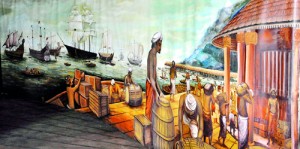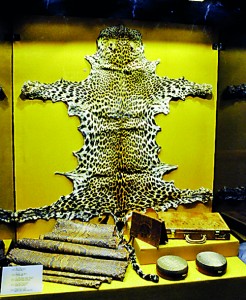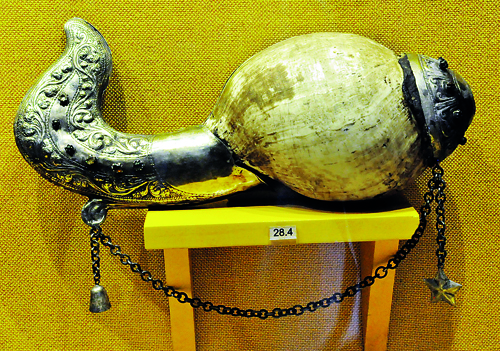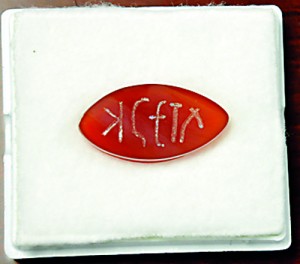What a catch through the ages!
In a tiny corner of a plush building down Main Street in the throbbing heart of the Pettah, there is much activity………….while the finishing touches are being added on a huge painting, the ‘people’ who will be before it are in the process of being “dressed”.
A Roman ship has docked at the harbour and the barrels on board are being ferried to shore, then lugged or rolled to a circular building with ornamental tiles adorning it. With this scene-setter as the backdrop, will come the table with an official seated behind it, flanked by two guards, as an interpreter begins his work and a Roman awaits the calculation of taxes for his goods.

The scene setter-- a Roman ship docks at the harbour. Pix by Susantha Liyanawatte
Welcome to the Sri Lanka Customs Museum at the ‘Customs House’, both of which will be opened by President Mahinda Rajapaksa on July 14, accompanied by the Director-General of Customs, Jagath Wijeweera.
The Customs Museum has been a long time in the making, the dream of about 25 years of the current Deputy Director of Customs, Samantha Gunasekara, at last becoming a reality this month.
Laboriously and meticulously collecting all the items the Customs Officers at all entry and exit points of ports and airports, have detected and confiscated, Mr. Gunasekara and his team are now in the final phase of putting in place what they believe is a treasure trove.
The theme of the museum is ‘Evolving of the Sri Lanka Customs’.
While the vision is the ‘Prestigious heritage of Customs for future generations’, he is quick to point out that the mission of the museum is not only the ‘collection and restoration of artefacts and models of forfeited items’, but also to serve as a research and conservation centre.
Usually, the practice has been to deposit “nearly lost” detected and forfeited items at state organisations such as the National Museum and the Department of Archaeology, explains Mr. Gunasekara, pointing out that with the Customs wanting to have their own museum, the trend has now caught on. The live specimens in Customs detections are sent to the Botanical or Zoological Gardens or released into the natural habitat.
Much labour has gone into getting the ‘scene’ of the Roman awaiting taxation, just right, as also every exhibit. Having pored over books and other literature, each

Leopard and python skins share a cabinet
figure is being clothed meticulously and Mr. Gunasekara underscores that every detail has been looked into. The Customs official wearing a redda and not a dhoti Indian-style is very Sri Lankan. He is bare-chested and even his arm-bands have been given much thought.
Just past the port scene, is a replica of the Godavaya stone inscription (sel lipi) during the time of King Gajaba (112-34 A.D.) of one of the oldest Customs records, setting the tone for the museum.
A chat in Mr. Gunasekara’s office about the different ‘Profiles’ that would be displayed at the museum is followed by a walk-through, peering at priceless pieces inextricably linked to the historical, natural and cultural heritage of this country.
Sri Lanka being a strategically-placed trade hub between east and west since historical times, there seems to be both historical and archaeological evidence of a well-organised Customs service at the ancient sea-ports, he says.
“If there were cross-border exchanges, as there have been, there would have been taxation and that would have led to the birth, development and evolution of the Customs to what it is today. The service had become formalised with the establishment of the modern Customs under the first Comptroller-General Antonio Bertolocci on June 14, 1809 under the British, adds Mr. Gunasekara.
The rest is history – the enactment of the Customs Ordinance in 1869; the introduction of the Unified Customs Service in 1968; and later a fully-fledged organisation in the light of the expansion of international trade.
The museum ‘Profiles’ cover a range from ‘Customs History – both old and new’, to ‘Wildlife items’, ‘Archaeological items’ and ‘Education services’ which have models of rarely-seen items.
There seems to be evidence of a Customs-service being in place as far back as 1,500 B.C. with the import of horses, goats and cattle, he says, adding that the museum will display prominently, photographs of a fragment of a patraya and also of a carnelian ear-stud dating back to 400-600 B.C. courtesy of former Deputy Director-General of Archaeology, Dr. Nimal Perera.
The display list is endless – a relic casket wrapped in silk (an import) dating back to 250-300 B.C. found at Deliwala, Kotavehera; a specimen of a red garnet excavated from Ridiyagama which is said to have exported large quantities of these semi-precious stones through Godavaya to Medieval Europe; the British flag, proudly displaying not only the fact that it is His Majesty’s Customs but also the symbols of the dagoba and the elephant; telescopes used at coastal outposts; the early Customs Ordinances with annotations by those who used them; and the ‘Ekanite’, the gem stone of radioactive minerals named after Mr. Ekanayake, a Customs gem-appraiser in 1952.
Cabinets have seashells, both local and foreign, insects including scientific collections that people attempted to smuggle out; animal skins of leopard and python; feathers; rhino horns; stuffed turtles seemingly in their own under-water environment including black corals et al believed to be 600 years old; wood; an edible bird’s nest “worth more than gold”; ivory ornaments, tusks, elephant hair; a

Intricately decorated chank -- 18th-19th century
Dutch-period writing bureau with all its little drawers; girayas (arecanut-cutters) in different shapes and sizes and a very old killota or chunnam-holder with its own tiny spoon.
Buddha statues are aplenty, with a small ivory statue having its very own allure.
While the ‘kastana’, a ceremonial sword of the Dutch era attracts any visitor, the ‘shahtoosh’ of Tibetan origin has its own tale wrapped around it.
Taking us to Tibetan heights, where an endangered antelope is hunted for its fur, Mr. Gunasekara describes how the wool is then smuggled across the border to Kashmir where weavers are exploited by mafia-like families to produce these shawls of finest quality. The ‘shahtoosh’ (meaning the ‘king of wool’) then hits the world’s fashion hotspots such as Paris, London and New York, bringing in anything between US$ 35,000 and 100,000 each.
A large item that catches the eye is the cast-iron fountain that Customs mudliyar Romanis Peiris erected at the Head Office back in 1860 to commemorate the jubilee of Queen Victoria.
The Silk Route and the ports of this country which have played a major role are highlighted on a big map on the wall as also the ships including Arabian, Greek and Chinese, along with Sri Lanka’s very own ‘Yathra Droni’ that would have come a-calling at the different ports, getting their little haven at the museum.
The buildings too down the ages have not been forgotten with the language unique to the Customs being superimposed on the photographs, while the ‘Roman getting taxed scene’ depicts what the Godavaya entry-point would have looked like with its circular Customs office.
“An entire Customs building lies buried in the sands of time at Kirinde in the south according to Prof. Raj Somadeva of the Post-graduate Institute of Archaeology and we have two roof-tiles from there to be exhibited here,” says Mr. Gunasekara.
In this venture, much support has been extended by DG Wijeweera, Director of Customs Leslie Gamini, Assistant Superintendents of Customs, K.P.D.H. Kaushalya & Dilan Weeraratne, all the staff members of the Biodiversity, Cultural and National Heritage Protection Division, many other Customs officials as well as government and non-government organizations and individuals, says Mr. Gunasekara, adding that the Coordinator was the Deputy Director of the National Museum, Senarath Wickramasinghe.
The journey through the museum may be brief but each and every exhibit reveals the milestones, down the ages, of the important and long voyage of the gate-keepers of this nation.
| The seal from an ancient port
The brightest sparkler, though a replica, among the many valuable exhibits will be the Carnelian Customs seal found at Godavaya, an ancient port in the south dating back to 200 B.C. The seal, with five Brahmi letters, which had been part of a ring, had been used by a high-level Customs officer who was in charge of exporting spices, especially cinnamon, at Godavaya, says Mr. Gunasekara, quoting Prof. Somadeva. The lettering depicts the word ‘atukurasa’ which means spices, it is learnt. “The replica is made of carnelian that we brought from Jaipur, India, and carved with the lettering,” adds Mr. Gunasekara for whom this is the favourite amongst all. Meanwhile, the unique divisions of the Customs which have their own niche at the museum are Biodiversity Division, the Narcotics Control Unit, the Consumer Protection Unit, the Scanning Unit, the Gem Unit, the Chemical Unit, the ICT Division with its E-customs and networks and the Megaport Process Unit with their own special contributions. |



